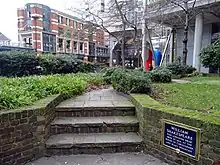51°31′02″N 0°05′40″W / 51.51735°N 0.09454°W Silver Street was a street in London. It ran from the north end of Noble Street at Falcon Square to Wood Street.[1] It originated in medieval times, and is one of the streets shown on a map known as the "Woodcut map of London" or the "Agas" map, which survives in a 17th-century version.[2][3]
Its inhabitants included the Mountjoy family with whom William Shakespeare lodged at the beginning of the 17th century.[3] According to Charles Nicholl, who has written a detailed analysis of Shakespeare's life on Silver Street, their house can be identified on the "Woodcut map".[4] The Mountjoys were Huguenots who ran a business making luxury headgear for ladies, including theatrical costumes.
During the Second World War the Cripplegate area, where the street was located, was virtually destroyed in the Blitz.
Legacy
_-_geograph.org.uk_-_491026.jpg.webp)
A commemorative stone marks the site of St Olave's Church, Silver Street, which was destroyed in the Great Fire of London.

On 21 April 2016, the City of London installed a blue plaque in Noble Street, near the site of the Mountjoys' house.[5][6] The plaque reads "William Shakespeare had lodgings near here in 1604, at the house of Christopher and Mary Mountjoy".
References
- ↑ 'Cripplegate, one of the 26 Wards of the City of London' Baddesley, J.J p76: London; Blades, East & Blades; 1921
- ↑ "Silver Street". Map of Early Modern London: edited by Janelle Jenstad (University of Victoria). Retrieved 10 February 2021.
- 1 2 Ralph Agas (attributed) (1633). "Agas' Map of London: William Shakespeare's Lodgings in Silver Street". London Picture Archive. Retrieved 7 March 2021.
- ↑ Nicholl, Charles (2007). The Lodger: Shakespeare on Silver Street. London. Allen Lane. The Lodger Shakespeare: His Life on Silver Street. New York: Viking.
- ↑ AFP (22 April 2016). "Anniversary Plaque Marks Site Of Shakespeare's London Home". Egypt Independent. Retrieved 7 March 2021.
- ↑ "Shakespeare plaque". Open Plaques. Retrieved 7 March 2021.